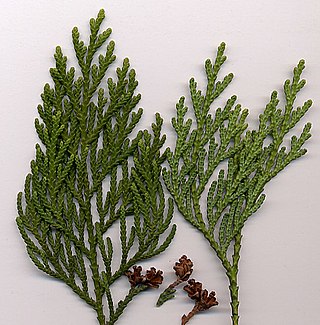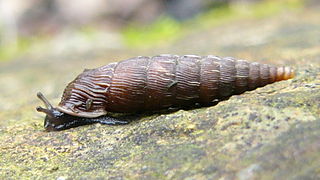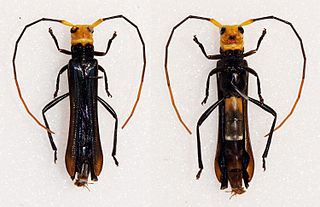
Thuja is a genus of coniferous tree or shrub in the Cupressaceae. There are five species in the genus, two native to North America and three native to eastern Asia. The genus is monophyletic and sister to Thujopsis. Members are commonly known as arborvitaes, thujas or cedars.

Thuja plicata is a large evergreen coniferous tree in the family Cupressaceae, native to the Pacific Northwest of North America. Its common name is western redcedar in the U.S. or western red cedar in the UK, and it is also called pacific red cedar, giant arborvitae, western arborvitae, just cedar, giant cedar, or shinglewood. It is not a true cedar of the genus Cedrus. T. plicata is the largest species in the genus Thuja, growing up to 70 metres (230 ft) tall and 7 m (23 ft) in diameter. It mostly grows in areas that experience a mild climate with plentiful rainfall, although it is sometimes present in drier areas on sites where water is available year-round, such as wet valley bottoms and mountain streamsides. The species is shade-tolerant and able to establish in forest understories and is thus considered a climax species. It is a very long-lived tree, with some specimens reaching ages of well over 1,000 years.

The Joinvilleaceae are a family of flowering plants with a single genus including four species. The APG II system, of 2003 assigns it to the order Poales in the clade commelinids in the monocots. The family consists of one genus with four currently accepted species, distributed from the Malay Peninsula to the Caroline Islands and high islands in the Pacific Ocean. It is evolutionarily significant as a relictual group closely related to grasses. They closely resemble large grass plants, in both general appearance and microanatomy, but possess fleshy fruits.

The gray sac-winged bat is a species in the family Emballonuridae which comprises the 51 species of sac-winged bats. It is found in Mexico from Baja California Sur and Sonora to Guatemala, El Salvador, Honduras, Nicaragua, Costa Rica and northern Colombia, at elevations up to 1,500 metres (4,900 ft).

Laciniaria plicata is a species of small air-breathing land snail, a terrestrial pulmonate gastropod mollusk in the family Clausiliidae, the door snails.

Spathoglottis plicata, commonly known as the Philippine ground orchid, or large purple orchid is an evergreen, terrestrial plant with crowded pseudobulbs, three or four large, pleated leaves and up to forty resupinate, pink to purple flowers. It is found from tropical and subtropical Asia to Australia and the western Pacific including Tonga and Samoa.

Plicatula is a genus of saltwater clams, marine bivalve molluscs, known commonly as kitten's paws or kittenpaws in the family Plicatulidae.
The pars plicata is the folded and most anterior portion of the ciliary body of an eye. The ciliary body is a part of the uvea, one of the three layers that comprise the eye. The pars plicata is located anterior to the pars plana portion of the ciliary body, and posterior to the iris. The lens zonules that are used to control accommodation are attached to the pars plana.

Plicatin B is a hydroxycinnamic acid found in Psoralea plicata.

Saperdini is a tribe of longhorn beetles of the subfamily Lamiinae.

Neonitocris is a genus of longhorn beetles of the subfamily Lamiinae, containing the following species:

Neonitocris princeps is a species of beetle in the family Cerambycidae. It was described by Karl Jordan in 1894, originally under the genus Nitocris. It has a wide distribution in Africa.
Neonitocris regina is a species of beetle in the family Cerambycidae. It was described by Karl Jordan in 1894.
Neonitocris gaboniensis is a species of beetle in the family Cerambycidae. It was described by Stephan von Breuning in 1956.
Neonitocris infrarufa is a species of beetle in the family Cerambycidae. It was described by Stephan von Breuning in 1956.
Neonitocris sibutensis is a species of beetle in the family Cerambycidae. It was described by Stephan von Breuning in 1956.
Neonitocris spiniscapus is a species of beetle in the family Cerambycidae. It was described by Stephan von Breuning in 1956.
Neonitocris calva is a species of beetle in the family Cerambycidae. It was described by James Thomson in 1868.
Neonitocris mangenoti is a species of beetle in the family Cerambycidae. It was described by Lepesme and Stephan von Breuning in 1953.
Neonitocris rubriventris is a species of beetle in the family Cerambycidae. It was described by Hintz in 1919.









